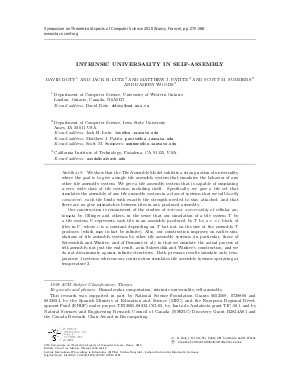Intrinsic Universality in Self-Assembly
Authors David Doty, Jack H. Lutz, Matthew J. Patitz, Scott M. Summers, Damien Woods
-
Part of:
Volume:
27th International Symposium on Theoretical Aspects of Computer Science (STACS 2010)
Part of: Series: Leibniz International Proceedings in Informatics (LIPIcs)
Part of: Conference: Symposium on Theoretical Aspects of Computer Science (STACS) - License:
 Creative Commons Attribution-NoDerivs 3.0 Unported license
Creative Commons Attribution-NoDerivs 3.0 Unported license
- Publication Date: 2010-03-09
File

PDF
LIPIcs.STACS.2010.2461.pdf
- Filesize: 317 kB
- 12 pages
Document Identifiers
Subject Classification
Keywords
- Biological computing
- Molecular computation
- intrinsic universality
- self-assembly
Metrics
- Access Statistics
-
Total Accesses (updated on a weekly basis)
0PDF Downloads0Metadata Views
Abstract
We show that the Tile Assembly Model exhibits a strong notion of universality where the goal is to give a single tile assembly system that simulates the behavior of any other tile assembly system. We give a tile assembly system that is capable of simulating a very wide class of tile systems, including itself. Specifically, we give a tile set that simulates the assembly of any tile assembly system in a class of systems that we call \emph{locally consistent}: each tile binds with exactly the strength needed to stay attached, and that there are no glue mismatches between tiles in any produced assembly.
Our construction is reminiscent of the studies of \emph{intrinsic universality} of cellular automata by Ollinger and others, in the sense that our simulation of a tile system $T$ by a tile system $U$ represents each tile in an assembly produced by $T$ by a $c \times c$ block of tiles in $U$, where $c$ is a constant depending on $T$ but not on the size of the assembly $T$ produces (which may in fact be infinite). Also, our construction improves on earlier simulations of tile assembly systems by other tile assembly systems (in particular, those of Soloveichik and Winfree, and of Demaine et al.) in that we simulate the actual process of self-assembly, not just the end result, as in Soloveichik and Winfree's construction, and we do not discriminate against infinite structures. Both previous results simulate only temperature 1 systems, whereas our construction simulates tile assembly systems operating at temperature 2.
Cite As Get BibTex
David Doty, Jack H. Lutz, Matthew J. Patitz, Scott M. Summers, and Damien Woods. Intrinsic Universality in Self-Assembly. In 27th International Symposium on Theoretical Aspects of Computer Science. Leibniz International Proceedings in Informatics (LIPIcs), Volume 5, pp. 275-286, Schloss Dagstuhl – Leibniz-Zentrum für Informatik (2010)
https://doi.org/10.4230/LIPIcs.STACS.2010.2461
BibTex
@InProceedings{doty_et_al:LIPIcs.STACS.2010.2461,
author = {Doty, David and Lutz, Jack H. and Patitz, Matthew J. and Summers, Scott M. and Woods, Damien},
title = {{Intrinsic Universality in Self-Assembly}},
booktitle = {27th International Symposium on Theoretical Aspects of Computer Science},
pages = {275--286},
series = {Leibniz International Proceedings in Informatics (LIPIcs)},
ISBN = {978-3-939897-16-3},
ISSN = {1868-8969},
year = {2010},
volume = {5},
editor = {Marion, Jean-Yves and Schwentick, Thomas},
publisher = {Schloss Dagstuhl -- Leibniz-Zentrum f{\"u}r Informatik},
address = {Dagstuhl, Germany},
URL = {https://drops.dagstuhl.de/entities/document/10.4230/LIPIcs.STACS.2010.2461},
URN = {urn:nbn:de:0030-drops-24619},
doi = {10.4230/LIPIcs.STACS.2010.2461},
annote = {Keywords: Biological computing, Molecular computation, intrinsic universality, self-assembly}
}
